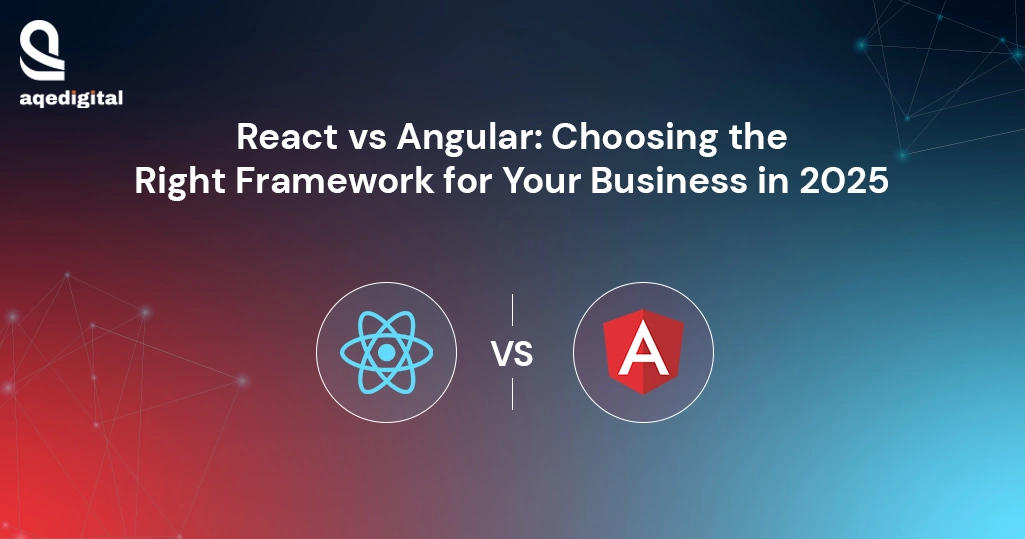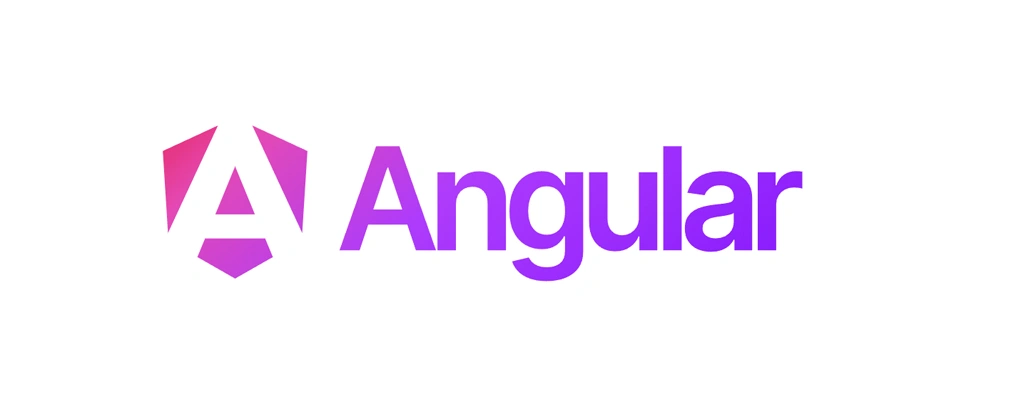
React vs Angular in 2025 remains a dominant debate as ever in modern web development. Both are powerful. Global companies trust both. Yet, they take very different paths. Choosing between them isn’t just a technical call; it shapes how fast your team moves, how secure your product stays, and how future-ready your investment is.
The challenge? There’s no one-size-fits-all answer. A startup chasing rapid growth won’t think the same way as an enterprise managing long product lifecycles. What works for a lightweight, user-first app may not hold up for a large-scale, multi-team system.
Understanding the strengths, trade-offs, and real-world applications of both can help businesses select the optimal foundation for their next major project.
Let’s take a closer look at both technologies to see which framework is the best fit for different business needs. We will break down the key differences, strengths, and future trends of both frameworks.
Let’s dive in!
What is React?
React was developed and is maintained by Meta (formerly Facebook) along with a large open-source community. It is a UI-focused JavaScript library, not a full-fledged framework. This makes it lightweight and flexible for different use cases.
One of React’s most significant strengths lies in its component-based architecture. Instead of building large, monolithic applications, React breaks the interface into independent, reusable building blocks called components. Each component manages its own state and logic, and can be combined to form more complex user interfaces.
React’s flexibility comes from its ability to pair with powerful tools such as:
- Redux for state management.
- Next.js for server-side rendering and SEO optimization.
- GraphQL for efficient data querying.
- Testing libraries, design systems, and countless third-party plugins.
The Virtual DOM feature of React translates business benefits directly into:
- Improved user experience: Interfaces feel faster and more responsive, keeping customers engaged.
- Higher retention and lower bounce rates: Smooth performance reduces frustration and encourages users to stay longer.
- Scalability without compromise: Applications can grow in size and complexity without degrading performance.
- Reduced development effort: Teams spend less time solving performance bottlenecks, accelerating release cycles.
For businesses, the impact is even more significant:
- Faster time-to-market: Teams can reuse components across multiple projects instead of starting from scratch.
- Lower long-term costs: Once built, components can serve multiple products or departments.
- Stronger collaboration: Different teams can work on separate components simultaneously without conflict.
- Consistent branding: Reusable components ensure the same design and functionality across platforms, strengthening the customer experience.
What is Angular?
Angular is a comprehensive front-end framework maintained by Google, that was first released in 2010 (as AngularJS). It is built on TypeScript and provides an all-in-one solution as a full-fledged framework for building robust, scalable, and enterprise-grade applications.
Angular’s Ahead-of-Time (AOT) compilation, tree-shaking, and change detection strategies ensure that large applications remain performant, even as features grow. This makes it suitable for mission-critical systems like banking portals or government platforms.
Angular follows a clear release roadmap with Long-Term Support (LTS), making it a reliable choice for enterprises that cannot afford disruptive technology shifts.
Angular includes features for which React typically relies on third-party tools:
- Two-way data binding for syncing data between UI and logic.
- Dependency Injection (DI) to manage services and resources efficiently.
- RxJS Observables for handling asynchronous operations like real-time data streams.
- Angular CLI for rapid scaffolding, testing, and deployment.
For businesses, Angular’s strengths often lie in:
- Consistency across teams: A structured framework ensures projects stay uniform, even with large developer groups.
- Enterprise-level scalability: Ideal for applications that require complex workflows, integrations, and long-term stability.
- Built-in security features: Protects against common vulnerabilities without heavy reliance on third-party libraries.
- Reduced decision fatigue: Since most tools are built in, teams spend less time choosing integrations and more time building.
React VS Angular: The Key Differences
While both are leading front-end technologies, they take very different approaches to solving the same problem: building modern, scalable web applications.
Understanding the React advantages over Angular helps business leaders identify when flexibility, speed, and ecosystem diversity align better with their digital goals.
React VS Angular: A Detailed Comparison (Business POV)
When it comes to choosing between React and Angular, businesses often look beyond the technical jargon and focus on what truly impacts timelines, budgets, and long-term scalability. Both frameworks are powerful, but they shine in different ways depending on the business goals.
1. Usability & Market Position
React continues to dominate in terms of popularity. Its widespread adoption across industries, coupled with strong developer preference, makes it the go-to framework for companies aiming to deliver modern, high-performance digital experiences.
Angular maintains its edge in the enterprise space. For businesses where stability, structure, and long-term support are non-negotiable, Angular remains a trusted choice, particularly for large organizations with multi-team environments.
2. Architecture & Performance
React’s Virtual DOM is designed for speed and responsiveness, which is why it’s so well-suited for user-facing applications where smooth interactions matter most.
Angular takes a different approach with its real DOM and advanced change detection. While this can make it feel heavier, it’s incredibly robust for complex enterprise systems, ensuring consistency across multiple modules.
3. Flexibility vs Standardization
React is unopinionated, allowing businesses to mix and match tools, and giving startups and fast-moving teams more agility.
Angular is opinionated, offering standardized solutions that reduce decision fatigue and help large teams maintain consistent development practices.
4. Scalability & Use Cases
React is often the better choice due to its agility and performance focus for lightweight to mid-scale applications. Startups, scale-ups, or product teams working under tight deadlines usually prefer React because its flexibility allows developers to quickly test ideas, iterate on features, and adapt to user feedback without being tied to rigid structures.
Angular shines with its built-in capabilities, enterprise-level scalability, and stronger security features for enterprise-grade, large-scale projects. Features like built-in dependency injection, a powerful CLI, and integrated security mechanisms reduce complexity for large projects and bring predictability to the development cycle.
5. Testing & Security
React relies on third-party tools like Jest or Enzyme for testing and often requires additional libraries to ensure security. For smaller teams or fast-moving startups, it’s do-it-yourself approach works well because it provides maximum flexibility and minimal upfront overhead.
Angular, by contrast, has built-in testing frameworks and integrated security features such as sanitization and dependency injection, reducing risks and manual overhead. For industries like finance, healthcare, and government, where compliance and security are non-negotiable, Angular’s built-in safeguards can translate into real cost savings and reduced risk.
6. Learning Curve & Talent Pool
React is easier to adopt, thanks to its JavaScript-first approach and flexible ecosystem, making it easier for businesses to find developers quickly. This accessibility translates into a larger global talent pool, making it easier for companies to hire, onboard, and scale teams without significant training overhead.
Angular has a steeper learning curve due to TypeScript, RxJS, and its opinionated structure, but that same rigor ensures long-term maintainability and fewer inconsistencies across teams. For decision-makers, the trade-off often comes down to whether speed of onboarding or long-term structural consistency is the bigger priority.
7. Update Frequency & Longevity
React’s incremental updates help businesses to adopt changes gradually with minimal disruption. For companies with limited engineering capacity or for products that require continuous delivery, React’s update strategy feels less disruptive and more aligned with agile development practices.
Angular gives major version updates with breaking changes, but also offers Long-Term Support (LTS), crucial for enterprise stability. Businesses in regulated sectors, such as finance, insurance, or healthcare, find this structured support invaluable because it minimizes risks tied to framework obsolescence.
When Should a Business Select React?
For organizations aiming to balance speed, agility, and user engagement, React often emerges as the smarter choice. The React advantages over Angular become clear when projects demand quick MVP launches, broad community support, and seamless integration with modern tools.
1. Speed-to-Market and MVP Development
Ideal for MVPs and prototypes, React’s lightweight nature and vast third-party libraries help teams launch quickly and capture market opportunities.
2. Talent Availability and Cost Efficiency
Built on JavaScript, React offers a large talent pool, reducing hiring costs, onboarding time, and dependency on niche expertise.
3. Superior User Experience and Performance
React’s Virtual DOM powers smooth, responsive interfaces—crucial for eCommerce, SaaS, and real-time apps that rely on user engagement.
4. Flexibility for Innovation
Its unopinionated approach supports modern stacks like Next.js, GraphQL, or serverless, enabling businesses to innovate without limits.
5. Cross-Platform Consistency
With React Native, brands can leverage cross-platform development to deliver consistent web and mobile experiences while reusing code to cut costs and speed delivery.
6. Strong Ecosystem and Community Support
Backed by a massive community, React ensures long-term viability with continuous updates, tools, and best practices.
Ideal Use Cases for Businesses
- Startups building MVPs or fast-scaling products.
- Companies that rely heavily on user-facing, high-performance apps (eCommerce, FinTech dashboards, social apps).
- Organizations prioritizing cross-platform reach (web + mobile).
- Businesses need a large, readily available pool of developers.
- Product teams are experimenting with modern, flexible architectures rather than being tied to a rigid framework.
When Should a Business Select Angular?
For enterprises that value stability, security, and long-term scalability, Angular often proves to be the right strategic choice. The React framework vs Angular debate usually comes down to flexibility versus structure. React lets you mix and match, while Angular provides a complete framework that keeps large projects more uniform.
1. Enterprise-Grade Stability and Governance
Backed by Google, Angular enforces structure and rules—ideal for regulated industries where predictability and compliance matter.
2. Long-Term Projects and Product Lifecycles
TypeScript-first architecture reduces runtime errors and lowers maintenance costs, making Angular a fit for 5–10 year product lifecycles.
3. Security and Compliance Requirements
XSS, CSRF, and DI protections are built in, helping enterprises meet strict compliance and security needs.
For businesses, ensuring protection against threats such as XSS or CSRF is non-negotiable. If you’re looking to go a step further, exploring approaches like enhancing web app security using OAuth and JWT can add an extra layer of trust and resilience to your applications.
4. Large-Scale, Multi-Team Collaboration
Angular’s opinionated structure standardizes workflows, easing coordination across large or distributed teams.
5. Rich Built-In Capabilities
Routing, forms, HTTP, RxJS, and testing come packaged reducing reliance on third-party integrations and speeding onboarding.
6. Performance at Scale
Optimized for structured, data-heavy apps like ERP or Mobile CRM apps, Angular handles complexity and scale reliably.
Ideal Use Cases for Businesses
- Enterprises developing mission-critical applications (banking portals, healthcare systems, government apps).
- Organizations with strict security and compliance needs.
- Businesses are planning for long-term, large-scale projects with multiple stakeholders.
- Companies prioritize predictable development processes over flexibility.
- Teams are already invested in TypeScript-first development.
Partnering with experts in white label web development can give you the technical clarity and execution support you need without adding strain on your in-house teams.
Why Businesses Pick React Over Angular
- Faster Launches – Reusable components speed up development and updates.
- Easy Talent Access – A large developer pool keeps hiring costs efficient and straightforward.
- Better Performance – Virtual DOM ensures smoother, faster user experiences.
- Rich Ecosystem – Works seamlessly with tools like GraphQL, Redux, and Next.js.
- Flexibility – Freedom to choose the right stack without rigid rules.
Angular Features Businesses Shouldn’t Ignore
- Ready Out-of-the-Box – No need to chase third-party tools, routing, forms, and RxJS are built in.
- Built for Scale – Handles enterprise workloads and multi-team projects with ease.
- Security Confidence – Core protections against common threats come standard.
- Developer-Friendly CLI – Cuts down setup time and speeds releases.
- Reliable Backing – With Google’s support, it stays future-proof and enterprise-trusted.
Future Trends: React, Angular & Microfrontends
Here are some of the key future trends that enterprises should focus on while building apps with React and Angular.
Micro-Frontends
Modern development increasingly embraces micro-frontends, enabling teams to combine frameworks like Angular and React within a single application. This modular approach allows independent deployments, parallel team workflows, and flexibility in technology choices.
Enterprises leverage micro-frontends to balance innovation with maintainability, delivering seamless user experiences while supporting complex, evolving digital products.
Cross-Framework Use
Development teams are blending frameworks to accelerate delivery without compromising quality. React’s agility pairs with Angular’s structured architecture, allowing projects to benefit from rapid UI updates alongside robust enterprise features.
Cross-framework strategies, supported by tools like Nx Monorepos, help businesses modernize incrementally while optimizing team productivity and reducing dependency bottlenecks.
AI & Automation
React powers dynamic, AI-enabled interfaces, including chatbot development, recommendation engines, and predictive dashboards, while Angular excels in enterprise automation workflows.
React’s flexible rendering adapts well to real-time AI insights, whereas Angular’s structured framework simplifies complex internal processes. Such synergy enables businesses to deliver intelligent, responsive experiences tailored to both consumers and employees.
Hybrid Adoption
Enterprises increasingly adopt a hybrid approach: React for customer-facing apps and Angular for internal systems.
React delivers speed, responsiveness, and a rich ecosystem for external engagement, while Angular provides maintainability, type safety, and scalability for enterprise workflows. This dual strategy balances innovation with operational stability across diverse application landscapes.
React is expected to remain the top choice for modern, consumer-focused applications, supported by a thriving ecosystem and strong cross-platform app development capabilities.
Angular, meanwhile, maintains a strong presence in enterprise environments where structured architecture, long-term maintainability, and robust tooling are critical. Both frameworks continue to complement diverse organizational needs and technology strategies.
React vs Angular: Which Should You Choose?
The decision between React and Angular should align closely with your business goals. React works best for companies that need speed, flexibility, and highly engaging customer-facing apps. Angular, on the other hand, is a strong fit for enterprises seeking consistency, built-in security, and long-term scalability.
The fundamental difference between React and Angular lies in how they align with your business priorities. An experienced Angular and React development partner can help you translate that choice into long-term success.
How AQe Digital Can Help You With The Decision?
The easiest way to know it is to evaluate the complexity of your project, your team’s expertise, and future growth plans before making the call. And remember, pairing the right framework with a robust website for better administrative work management can significantly improve efficiency and overall business performance.
At AQe Digital, we help companies cut through the noise by assessing project needs, scalability demands, and long-term vision before recommending the proper framework. Our expertise goes beyond recommendations. We specialize in full-cycle web app development, ensuring the framework chosen aligns with your long-term growth and delivers real business impact.
FAQs
React vs Angular debates often come down to project needs. React offers agility and faster UI rendering, while Angular provides structured solutions, strong security, and scalability, making it better suited for enterprise-grade web design and development services.
Angular vs React comparisons show Angular’s structured ecosystem scales better for large enterprise projects. React, however, excels for fast-moving teams needing agility, reusable components, and custom third-party tools to support mid-size business applications.
React advantages over Angular include faster UI updates with Virtual DOM, flexibility in choosing tools, a large developer pool, and reusable components that speed up development cycles for businesses seeking cost-efficient, modern digital experiences.
Key Angular features include built-in routing, RxJS observables, form handling, dependency injection, and Google’s long-term support. These make Angular a reliable choice for enterprise web apps needing structure, scalability, and strong security.
The difference between ReactJS and AngularJS is that ReactJS is a UI library offering performance boosts with Virtual DOM, while AngularJS is a full framework, providing structured solutions but with a steeper learning curve.
React framework vs Angular performance debates favor React for fast, interactive UIs. Angular, though slightly heavier, excels at handling large-scale enterprise systems where consistency, compliance, and multi-team development matter most.
Every React project should use technologies like Redux for state management, Next.js for server-side rendering, GraphQL for APIs, and testing tools like Jest. These strengthen the performance, scalability, and maintainability of business apps.
A React JS development company provides expertise in building fast, scalable, and engaging web apps. Businesses benefit from reusable components, Virtual DOM performance, and flexible integrations with modern tools and APIs.
React JS development services cover UI/UX design, custom component development, performance optimization, API integrations, and maintenance. They ensure businesses get scalable, secure, and future-ready applications tailored to specific industry needs.
Yes, Angular microfrontend with React is increasingly popular in hybrid adoption. Enterprises combine Angular for structured, scalable modules with React for dynamic user interfaces, achieving both stability and agility in complex applications.





